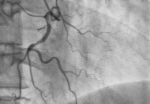Percutaneous treatment of chronic total occlusion (CTO) has traditionally been via the transfemoral approach (TFA). The use of the transradial approach (TRA) in complex coronary interventions has been increasing. A randomized study assessed the use of TRA vs TFA in complex PCI (58% CTO) and TRA saw favorable outcomes. The aim of this prospective, randomized,...
EuroPCR 2021 | COLOR: Complex PCI via Transradial vs Transfemoral Approach
Treating total occlusions, complex bifurcations, grossly calcified lesions or left main lesions via transradial approach is associated with significant reduction in access-site bleeding or vascular complications vs transfemoral approach. This kind of procedures have been typically excluded from studies randomizing patients to transradial vs transfemoral approach. The COLOR study used the transradial bore-guiding catheter Glidesheath...
MATRIX: Impact of Crossover from Radial Access to Femoral Access
The new MATRIX trial, recently published in JACC Interv., shows that an access-site crossover from radial to femoral access in patients with acute coronary syndrome cancels out the benefit provided by radial access as regards bleeding. However, there are no signs of comparative damage between successfully conducted radial or femoral access as a first attempt. ...
The Transradial Approach Continues to Be the Best for Primary PCI
The transradial approach has been associated to lower mortality and bleeding rates in patients receiving primary PCI for ST elevation MI. This had been called into question by the recent SAFARI-STEMI, but after including its outcomes in a new meta-analysis, the scales tilted slightly in favor of the transradial approach vs. the transfemoral. The transradial...
A Simple Trick to Improve Our Transradial Punctures
Transradial access is here to stay; that much has been clear for some time now. However, some operators still resist change and the systematic use of this technique shows great geographical dispersion. Some of its limitations are a difficulty to obtain access and the somewhat frequent occurrence of radial artery occlusion after the procedure. This...
Manual vs. Mechanical Compression after Transradial Catheterization
For patients undergoing transradial catheterization, whether puncture site compression is manual or mechanical has no significant difference as regards post procedural radial artery occlusion (RAO) rate. Hemostasis is shorter with manual compression, but it seems difficult to implement in the clinical practice. We could carry out an economical sub-analyzis of this study to find out...
Transulnar Access: Another Ace Up Our Sleeve Before Transfemoral Access
Transulnar access can be as safe and effective as transradial access, and it is a particularly good alternative for the preservation of radial artery patency or when such vessel presents a difficult anatomy. This new meta-analysis that will be published soon in Catheter Cardiovasc Interv showed a relatively high failure rate for that access, but...
Arterial Access After Thrombolysis
In the subgroup of patients with ST-segment elevation myocardial infarction who fail thrombolysis, transradial access reduces both bleeding and mortality, according to the results of this new study recently published in JACC Cardiovascular Interventions. Overall, transradial access following failed thrombolysis was associated with a 70% reduction in vascular complications, a 28% reduction in combined in-hospital...
Though on the Rise, the Transradial Approach to Primary PCI Remains Underused
There is evidence to support the use of the transradial approach to coronary angioplasty. Several randomized studies have shown reduced bleeding and vascular complications when adopted, compared against patients treated with the femoral approach. There are also studies and meta-analysis suggesting that, in the context of primary PCI, the benefit would be even bigger, with significant events...
The transradial approach reduces the risk of kidney injury in acute patients
It remains unclear whether transradial access, compared with transfemoral access, presents a different risk of post-procedural kidney injury for patients admitted with acute coronary syndrome. Historically, it has been considered (without any evidence) that, given the higher difficulty associated with transradial access, it would require longer fluoroscopy time and higher contrast volume, which would eventually...









